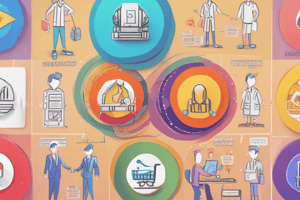Podcast
Questions and Answers
Match the stages of the business life cycle to their correct order.
Match the stages of the business life cycle to their correct order.
1 = Existence 2 = Survival of the fittest 3 = Success 4 = Take-off 5 = Maturity
What three characteristics help identify a business opportunity?
What three characteristics help identify a business opportunity?
Price, quality, and service.
Which two documents summarize the business plan of a company?
Which two documents summarize the business plan of a company?
Pitch Deck and Lean Canvas.
Match each stage of the business life cycle to its corresponding definition.
Match each stage of the business life cycle to its corresponding definition.
In which business life cycle stage is Mike, the owner of a doggy daycare and grooming business, currently in?
In which business life cycle stage is Mike, the owner of a doggy daycare and grooming business, currently in?
An executive summary should briefly explain everything in a business plan in _____ pages.
An executive summary should briefly explain everything in a business plan in _____ pages.
What are two advantages to selling digital products?
What are two advantages to selling digital products?
In which business life cycle stage is Dylan, who owns a small grocery store facing low business and profits?
In which business life cycle stage is Dylan, who owns a small grocery store facing low business and profits?
Which is a characteristic of a business opportunity?
Which is a characteristic of a business opportunity?
Factors that aid in determining whether or not a business opportunity is viable include market size, _________, manage of cash flow, management skillsets, and passion.
Factors that aid in determining whether or not a business opportunity is viable include market size, _________, manage of cash flow, management skillsets, and passion.
Arrange the stages of a business life cycle in order.
Arrange the stages of a business life cycle in order.
In what order should the steps of the design thinking process be taken?
In what order should the steps of the design thinking process be taken?
Match the characteristic with its definition.
Match the characteristic with its definition.
Match the characteristic with its definition.
Match the characteristic with its definition.
Flashcards are hidden until you start studying
Study Notes
Business Life Cycle Stages
- Stages in order: Existence, Survival of the Fittest, Success, Take-off, Maturity
- Existence: Introduction phase; focus on gaining market attention.
- Survival of the Fittest: Emphasis on revenue management, expenses, and market growth.
- Success: Business is stable and profitable.
- Take-off: Implementation of expansion strategies.
- Maturity: Established business with delegated responsibilities, significant market share.
Identifying Business Opportunities
- Key characteristics: Price, quality, and service identify viable business prospects.
- A business opportunity should provide necessary support for buyers, including location assistance.
Business Plan Summaries
- Essential documents: Pitch Deck and Lean Canvas encapsulate the business plan.
- Executive summary should summarize the business plan in two pages.
Digital Products Advantages
- Not requiring physical storage or inventory.
- Instantaneous and cost-effective delivery methods.
Business Life Cycle Challenges
- Mike, an owner of a doggy daycare in the Take-off stage, seeks financing for growth.
- Dylan, running a struggling grocery store, is in the Pivot or Persist stage, addressing low profits.
Assessing Viability of Business Opportunities
- Determining factors include: Market size, relationships, management competency, cash flow management, and passion.
Design Thinking Process
- Steps in order: Empathize, Define, Ideate, Prototype, Test to foster innovation.
Characteristics for Entrepreneurship
- Self-Reliance: Confidence in one's abilities and goals.
- Forward-Thinking: Planning for future opportunities.
- Initiative: Transforming ideas into actionable steps.
- Resiliency: Ability to adapt to challenges.
- Grit: Persistence in face of obstacles.
- Risk Tolerance: Comfort level with potential investment losses.
Collaborative Skills
- Critical Thinking: Evaluating various solutions to problems.
- Creativity and Innovation: Generating unique and effective ideas.
- Collaboration: Teamwork towards shared objectives.
- Problem-Solving: Crafting effective solutions for challenges.
- Personal Agency: Independent goal achievement without external direction.
- Ethical Practices: Moral decision-making in business operations.
- Social Responsibilities: Ethical behavior to protect businesses and communities from harm.
Studying That Suits You
Use AI to generate personalized quizzes and flashcards to suit your learning preferences.




